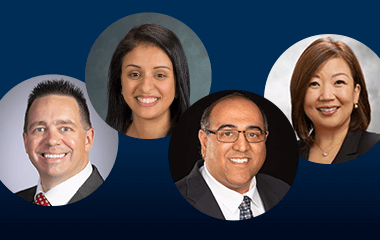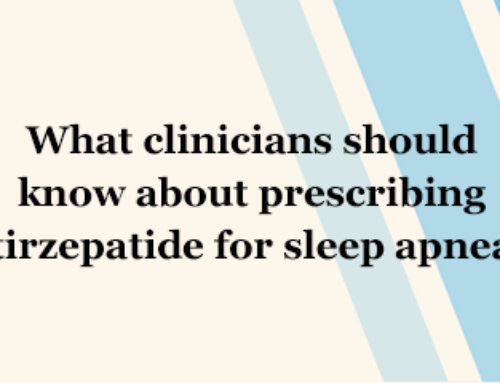The Early Career Physician Assembly is an online community for members who are early in their sleep medicine careers, giving them an opportunity to network and learn from colleagues with a similar professional background. AASM member students, fellows, trainees, and physician members under 40 years old are automatically included in the assembly.
Leaders of the assembly asked AASM members in academic sleep medicine what they wish they had known when transitioning from a fellowship to their new career. We heard from recent fellowship graduates, David Earl, MD, PharmD, and Sullafa Kadura, MD; a new program director in mid-career, Joyce Lee-Iannotti, MD; and AASM President Raman Malhotra, MD. They described their challenges and successes and provided advice to new sleep practitioners.
David C. Earl II, MD, PharmD
Dr. Earl specializes in psychiatry and sleep medicine. He received his doctorate in pharmacy in 2008 followed by his doctorate in medicine in 2016. He completed his residency in psychiatry at the University of New Mexico in 2020. He was a sleep fellow at the University of New Mexico Sleep Disorders Center in 2020-2021 and now practices sleep medicine and psychiatry at the UNM.
Q: What did you find challenging about the transition into your new career after fellowship?
Dr. Earl: I felt uncertain about the contract process as the details were not particularly clear to me, and the contract was not made available until just before the start date. I had to negotiate my position with my primary specialty as I am working at an academic center, and while that process was not particularly uncomfortable, it did add time to the hiring process as two departments are funding fractions of my salary. Uncertainties related to the financial effects of the pandemic, as well as the recent use of a consulting firm to help my employer improve revenue, led to the inability of some of my superiors to fully inform me as to what to expect.
Q: What helped with this transition?
Dr. Earl: The transition to attending life was made easier by my program director guiding me through the process. The fellowship did a really good job of preparing me for what to expect.
Sullafa Kadura, MD, MBA
Dr. Kadura is an assistant professor of clinical medicine in the department of medicine and pulmonary/ critical care at the University of Rochester Medical Center, where she completed her sleep medicine fellowship in June 2021. She is also a director of clinical informatics.
Q: What advice would you give those that are transitioning into a new career after fellowship?
Dr. Kadura: Early preparation is essential before transitioning from fellowship to attending, especially since the sleep medicine fellowship is only one year. During our training, we had to settle for just any position with an already established template. This transition is very different.
I think the most critical step is knowing what you are looking for in a career. Sit back, reflect, and take the time to identify your values, needs, and wants – both professionally and personally. Be as specific as possible and prioritize from most to least important. Your values ideally will align with your new employer. Being clear about your wants and needs also increases your chances of successful negotiation.
The other thing is that potential employers may pressure you to make a decision too quickly. Give yourself several months to negotiate your needs and wants, compare other employment opportunities, and review your contract in detail.
Joyce K. Lee-Iannotti, MD
Dr. Lee-Iannotti is the director of the sleep disorders center and program director of the sleep medicine fellowship at the University of Arizona College of Medicine. She completed medical school at the University of South Carolina School of Medicine, residencies in internal medicine and neurology at the Cleveland Clinic Foundation, and fellowships in sleep medicine at the Cleveland Clinic and vascular neurology at the Mayo Graduate School of Medicine in Phoenix.
Q: What do you think is most challenging for those transitioning into a new career after fellowship?
Dr. Lee-Iannotti: I feel the transition is tough, regardless of whether the fellow plans to pursue an academic or a private practice career. Many fellows are PGY-4 to PGY-7’s and advanced in training, but I’m not sure anything truly prepares you for taking the dive into becoming a full-fledged faculty. Once you graduate, you are no longer “supervised” and expected to practice independently – this can be overwhelming!
Q: What advice would you give those to ease this transition?
Dr. Lee-Iannotti: First, realize that sleep medicine is a one-year fellowship, but the learning continues well beyond fellowship. I am 10+ years out and still learning new things every day! Sleep is multi-disciplinary and complex – this is what makes it so fascinating! For example, just today I realized in discussions with an ortho resident rotating with me that OSA is associated with osteoporosis and decreased bone-healing post-fractures! This led us to explore OSA as a risk facture for fractures/osteoporosis and decreased success after orthopedic surgeries. So, do not get frustrated if you feel like you don’t know everything – no one does. Continue to read journals, be involved in AASM, attend local sleep grand rounds, do CMEs, and commit yourself to being a lifelong learner.
Second, find good mentors and colleagues, people who can become invested in your learning and your success. They are the people you call for advice on a difficult patient, help with a book chapter, advice on leadership and political obstacles within your department or hospital. I have three mentors that I am grateful for every day, and I continue to benefit from their mentorship after a decade. I am also surrounded by extremely supportive colleagues.
Attend meetings, join the AASM, network! This keeps you “in the loop,” helps you find a sense of community with people who share your passion, and updates you on the latest and greatest advances in sleep medicine.
Find a niche. Be able to treat and manage every sleep disorder but find your true passion and area of interest. If you are an academician, this will build on your ability to be innovative and create pilot studies.
Be a great doctor; be a good person but also learn to be financially savvy, whether you’re in an academic position or private practice. Be conscientious of insurance coverage policies, financial flows and your overall financial security. Learn also to be a good manager – a well-supported clinic and knowledgeable staff will only benefit your patient.
Lastly, practice what you preach. Practice good sleep hygiene, work-life balance, wellness, stress relief, resilience, exercise, good health. In our realm of sleep medicine, all of these are so important. Patients will look to us to lead the way to sleep health.
Raman K. Malhotra, MD
Dr. Malhotra is president of the AASM and professor of neurology and program director of the sleep medicine fellowship at Washington University School of Medicine in St. Louis. He completed medical school at the University of Missouri – Kansas City School of Medicine, and a residency in neurology and a fellowship in sleep medicine at the University of Michigan Medical Center.
Q: What do you wish you knew going into attending life?
Dr. Malhotra: It would have been helpful to have more knowledge about typical clinical expectations (RVUs, encounters) for a clinician educator at an academic institution. I am sure this would have also been helpful to have if I was going into private practice. We usually only know about the practice environment that we trained at, and it can be helpful to learn about other practice environments.
Q: What helped with your transition into your new career after fellowship?
Dr. Malhotra: Past trainees who had already started their careers were very helpful to me. There were also resources available at the AASM and other medical societies that could be used for reference. I also felt meeting more sleep medicine providers in my stage in my career either at the APSS meeting or other events was very helpful.
Q: What advice did you seek?
Dr. Malhotra: I needed assistance with contract negotiation and making sure I was asking for the appropriate support as I started my career. It was also helpful to get advice about time management, and setting goals for the next three, five, and 10 years. It was helpful to try and identify specific goals and objectives that I could work toward, for example requirement for promotion to the next academic level at my institution. I also sought advice on how to become more active in the AASM.
For more resources about the transition from fellowship to an early career sleep medicine physician, check out these AASM resources:
- Early Career Physician Assembly – to connect with other early career physicians. Eligible members can access the assembly under “My Communities” on AASM Engage
- Choose Sleep – for educational resources and webinars, including contract negotiation and billing
- AASM Mentorship Program – to become a mentee or mentor
In the next issue of Montage, we will share advice from early career sleep medicine physicians in private practice.
This article appeared in the Winter 2022 issue of Montage, volume 7, number 1. To read more content from this issue, click the button below!





